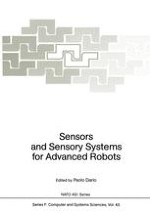1988 | OriginalPaper | Buchkapitel
Proprioceptive Feedback for Sensory-Motor Control
verfasst von : Manuel Hulliger
Erschienen in: Sensors and Sensory Systems for Advanced Robots
Verlag: Springer Berlin Heidelberg
Enthalten in: Professional Book Archive
Aktivieren Sie unsere intelligente Suche, um passende Fachinhalte oder Patente zu finden.
Wählen Sie Textabschnitte aus um mit Künstlicher Intelligenz passenden Patente zu finden. powered by
Markieren Sie Textabschnitte, um KI-gestützt weitere passende Inhalte zu finden. powered by
Among the natural sensors, which provide proprioceptive feedback during movement, the muscle spindle has attracted most interest since the sensitivity of spindle afferents to length variations of the host muscle is subjected to efferent control by fusimotor neurones (mostly γ-motoneurones). These are themselves controlled from numerous centres of the nervous system. Functionally, the perhaps most important feature of γ-action is that the fusimotor system, with its static (γS, sensitivity reducing) and dynamic (γD, sensitivity enhancing) components, possesses the potential of providing flexible gain (or sensitivity) control of spindle feedback. One of the most relevant pending issues in the field of peripheral control of movement is whether, and under which circumstances, this potential is used during physiological motor performance.This paper gives a brief overview of important functional properties of the sensory spindle afferents and of efferent fusimotor action and it addresses the question of fusimotor function during natural movement. It is pointed out, that strategies of fusimotor action, which have been encountered in reduced laboratory preparations, appear not be be adhered to during normal motor performance. An alternative concept of fusimotor function, the notion of fusimotor set, is presented. According to this, key features of fusmotor action are largely tonic γS and γD firing patterns (even during rhythmic movements, featuring rhythmic skeletomotor α-activity), suggesting independent central control of the skeletomotor and fusimotor systems,a dramatic switch from predominant and low-key static action (during routine motor performance) to predominant and powerful dynamic action (during unfamiliar motor tasks),gradual resetting of fusimotor drive of a given type during periods of motor adjustment.Thus, proprioceptive feedback from spindle afferents is not invariant. It appears to be adapted to specific requirements of motor tasks, conceivably to optimize motor control.
